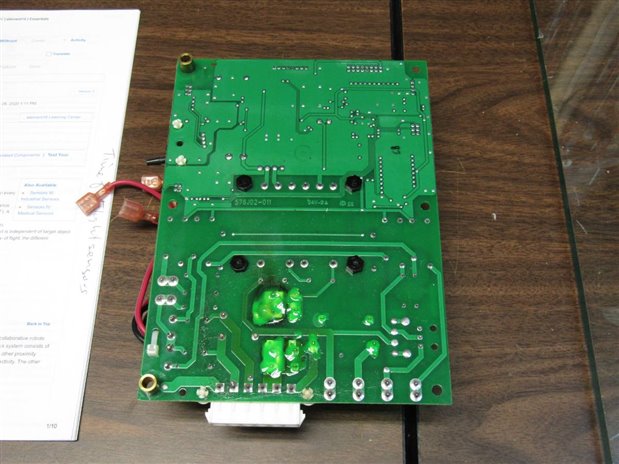This is the main circuit board from a Dental Clinic Sterilizer. It is a very popular brand that has been sold extensively across the USA as well as internationally. One of the power outputs of the board is controlled by a 30 amp relay that powers the main heating element which draws upwards of 12 Amps. The circuit is fused by a 15 Amp fuse (See the white ceramic fuse in the middle of the picture). The circuit board mounted fuse clips are rated at 20 Amps. This would all seem to be well engineered but as is often the case reality has seen fit to question the design. Over time the 20 Amp fuse clips tarnish and loose their spring. As they deteriorate the resistance between the clip and the fuse goes up and the resultant voltage drop causes them to heat and eventually fail. By the time they fail however the board around the fuse clip is carbonized and many times the failure results in arcing and fire. If the damage isn't too bad they are fixable.
Here is a board that was received from a client today.
The first picture is of the top with the fuse still installed, the second has the fuse removed and the third shows the underside of the board.
Anytime that a board has been damaged like this the board material has been heated to the point where it has become carbonized and will no longer act as an insulator. All of the damaged board must be removed. When we are done removing the burned board there will still be some cosmetic stain and darkness around the edge but it will no longer be a conductor. I like to use a square file to enlarge the hole. It is very easy with a file to determine when the damaged area has been removed as the file will be trying to cut hard circuit board material. It is my intention to clean out a rectangular section of the board and then graft in a new piece of circuit board that I have salvaged from a junk circuit board that I have stripped all the parts from.
Here is a picture of the circuit board with the burned material removed.
As you can see that the edge of the hole is still darkened a little but this will not affect the operation of the repair. The next picture shows the piece of salvage circuit board that has been trimmed and filed to fit the hole in the board. The graft board had a fuse clip on it before and the board is clad on both sides with two vias tying the top and bottom layers together.
The fuse clips that I install when I repair these boards are rated for 30 Amps and they have a much tighter grip. I have been fixing these board for over 15 years and have not had one of the repairs come back yet for a failure of the fuse clips. Before I fit the new graft into the circuit board I will solder the fuse clip into place. Experience has taught that this is better than putting the graft into place first. Here is the graft with the clip installed and the graft with the clip friction fitted into the sterilizer circuit board.
Before the graft is epoxied into place it is important to reconnect the clip to the circuit. The original power trace was on the underside of the board but to improve the repair we will make connections on the upper and lower sides of the board. The common mode inductor to the right of the new clip in the picture is where the fuse clip pad has to be connected. Copper solder wick braid makes a good foundation and trace between the connections.
With the fuse clip properly positioned and wired the epoxy is mixed and applied to both sides of the circuit. The fuse clip at the other end of the fuse is also replaced with a 30 Amp clip and a new 15 Amp ceramic fuse is installed in the clips. Once the left over solder flux is removed the connections are sealed with a green masking paint. These sterilizer circuit boards are often in a steamy moist environment so it is important to protect the bare connections to prevent corrosion.
The manufacturer of these boards sells the new replacements at a very high price. This creates room for technicians like me to spend the time necessary to fix them for a reasonable price and still be way under the cost of a new one. There is an older version of this board and sterilizer where the new boards are no longer available and the only recourse is to repair the boards that still exist. Most of the time that I get these boards they are either beginning to fail and I can use the existing solder pads and board for the 30 Amp clip upgrade or they have totally caught fire as in the pictures below and all I can do is salvage a few parts.
I have been waiting for several months for one with just the right amount of damage to come in so that the grafting repair technique could be demonstrated.
John















Top Comments
-

Andrew J
-
Cancel
-
Vote Up
+4
Vote Down
-
-
Sign in to reply
-
More
-
Cancel
-

jw0752
in reply to Andrew J
-
Cancel
-
Vote Up
+4
Vote Down
-
-
Sign in to reply
-
More
-
Cancel
Comment-

jw0752
in reply to Andrew J
-
Cancel
-
Vote Up
+4
Vote Down
-
-
Sign in to reply
-
More
-
Cancel
Children